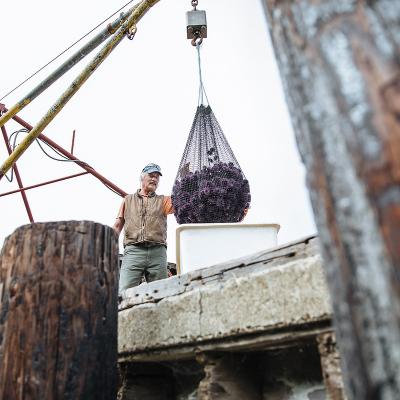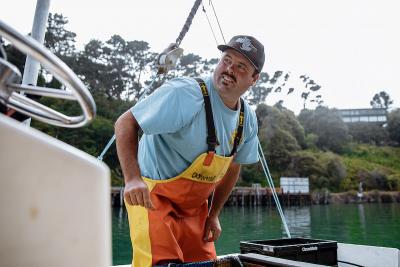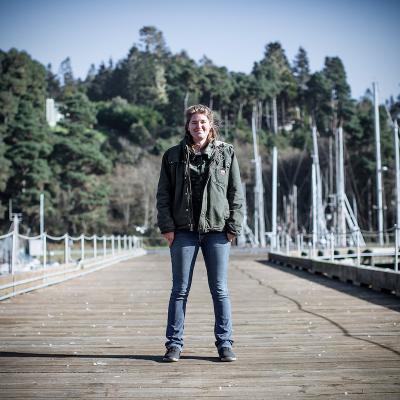Recent decades have been hard on Fort Bragg, California. The local sawmill shuttered in 2002, wiping out many jobs, and leaving behind a swath of underutilized coastline. Thanks to a welcoming small-town atmosphere and stunning ocean views, tourism remained one key economic lifeline — until the coronavirus arrived.

The city’s budget depends on a transient occupancy tax levied on hotel stays. Suddenly, stay-at-home orders left the hotels empty. The crisis prompted the city to launch an economic diversification study.
Officially, the study was focused on the site of the former mill. Given its size — more than 400 acres, nearly a third of Fort Bragg’s total footprint — and its prime location along the coast, its redevelopment was considered a potential game-changer for this small city of 7,000. But the study wound up directing the locals’ attention to an even larger site: the ocean itself.
“It became clear that we could couple Fort Bragg’s deep cultural connection to the ocean with investment opportunities — not only supporting our regional economy, but environmental resilience, too,” says Sarah McCormick, the city’s special projects manager. And now, with an assist from California Sea Grant, a batch of new ideas has emerged.
Turning to the Blue Economy
One phrase appeared again and again in the economic diversification report: “blue economy.”
The idea of the “New Blue Economy” was popularized a decade ago by the United Nations. Since then many other agencies and organizations have embraced the concept, which the World Economic Forum defines as “the sustainable use of ocean resources for economic growth, and improved livelihoods and jobs, while preserving the health of marine and coastal ecosystems.” The idea is, in essence, to find ways to create new jobs and build a healthier local economy that all help sustain local ecosystems, rather than extract from them.

Fort Bragg had already been thinking along these lines. In the early 2000s, the community decided to launch a marine science and education center to anchor the reuse of the mill site and help generate living wage jobs. Property donated by the city helped the Noyo Center for Marine Science get off the ground. Today, the center includes a museum and retail store downtown, an interpretive center perched at the edge of the headlands and a marine field station in Noyo Harbor. There are plans to build an Ocean Science Center on the headlands to support ongoing research and education. “We believe the Ocean Science Center is key to shoring up climate resilience on the Mendocino coast,” says Sheila Semans, the center’s executive director.
The marine center was already in place when the economic diversification study surfaced the idea of the blue economy. Soon the Noyo Ocean Collective emerged: a collaboration between several organizations dedicated to fostering economic innovations in the Fort Bragg region. Founding members of the collective included the City of Fort Bragg, Noyo Harbor District, Noyo Center for Marine Science, Sherwood Valley Band of Pomo Indians, Mendocino College and West Business Development Center.
“We recognize that building a vibrant blue economy will take the efforts of many organizations working collectively, and individually, to make this a reality,” says Mary Anne Petrillo, CEO of West Business Development Center. “When we bring our expertise to the table we can craft economically viable solutions for our coastal region.”
Symposium takeaways: For a summary of the sessions and takeaways of the Fort Bragg Blue Economy Symposium and Learning Festival, see this document.
Early on, McCormick reached out to California Sea Grant, whose extension team helped the collective organize a two-day symposium, followed by a two-day learning festival, in Fort Bragg in May 2022. “We’ve spent years researching what strategies can sustain ocean ecosystems and resilient coastal communities,” says Luke Gardner, a Sea Grant extension specialist who has worked closely with the collective. “It’s thrilling to see a community seize on these ideas.”
A challenging coastline
There are both challenges and upsides to Fort Bragg’s setting, alongside a natural harbor at the mouth of the Noyo River. The site hosted rich forests and access to ocean resources and once served as a seasonal settlement for the Pomo people, who would travel from the inland forests to collect seaweed and mollusks and catch migrating salmon. White settlers arrived in the nineteenth century, and the first local sawmill was built in 1852.
By the late nineteenth century, the timber industry was flagging. The fishing industry persisted, and even today, the 80 commercial fishing vessels that work out of the Noyo Harbor District still generate between $6 million and $14 million in annual revenue and provide roughly 300 jobs. But shifting regulations and markets have now hit this industry, too. And since Fort Bragg is distant from many of California's major academic institutions, there is a shortage of research on local economies and ecosystems.

Tucked along the mouth of the Noyo River, Noyo Harbor is outside the official boundaries of Fort Bragg. But the culture and economy of the harbor and the city are deeply intertwined: the fleet supplies fish to local processors, who sell to local restaurants and businesses, with each step in this chain providing more jobs — from truck drivers to fish processors to restaurant servers.
Keeping these businesses afloat has become harder in recent years. Algal blooms delayed the start of the last several Dungeness crab seasons, and issues with whale entanglement led to emergency closures. The most recent King Salmon season was canceled after failed runs on the Sacramento River, and the nearshore rockfish fishery has faced closures, too, due to low populations. Local kelp populations have collapsed, which has impacted the red urchin fishery.
“It's not, ‘The climate is changing; we’re worried about change; how do we plan for change?’” says Anna Neuman, the Noyo harbor master. “Our ocean ecosystem has changed, period. That happened. The question is what do we do now.”
The collective’s answer? Work together to build a new economy. The college will train a workforce; the West Business Center can support entrepreneurs; the Noyo Center will supply research. Much of the resulting economic activity, meanwhile, will center on the harbor district.
Already, progress is underway: the National Oceanic and Atmospheric Administration, for example, has provided money to launch a conservation aquaculture pilot project at the Noyo Center’s field station. The harbor district has grant funding from the California Employment Development Department’s Community Economic Relief Fund that supports, among other initiatives, a new state-of-the-art icehouse.
One of the city’s key goals is to lower barriers and support other local institutions. To that end, with funding from the California Coastal Commission, McCormick’s office is developing a “Noyo Harbor Blue Economy Visioning, Resiliency and Implementation Plan.”
Extending the impact
As part of that effort, McCormick partnered with California Sea Grant to host a Coastal Mendocino Extension Fellowship — a paid position, jointly managed by McCormick, as the city’s Special Projects Manager, and by California Sea Grant’s extension team.

Earlier this month, Jami Miller, a recent graduate of the master’s program in marine affairs at the University of Rhode Island, settled in Fort Bragg. Over the next two years, she will help collect the baseline ecological and economic data needed for the new resiliency and implementation plan.
Miller grew up in southern California, where — whether surfing or playing volleyball or simply hanging out — she spent plenty of time at the beach. That helped prompt her graduate studies. Miller’s thesis focused on how recreational anglers — and particularly fishers from marginalized racial and ethnic backgrounds, who are less often studied — contribute to local food systems. To broaden her understanding, Miller also completed a certificate in fisheries and aquaculture.
She is excited about the opportunity to take her training back to her home state to help develop the blue economy plan and also to continue learning. “I can give my expertise in what I know,” she says. “But I’ll be guided by the people who live there and who have that expert knowledge of what it is to be in Fort Bragg.”
Neumann notes that Miller’s presence, as a representative of Sea Grant, gives validation to the Fort Bragg Blue Economy efforts: a confirmation that even groups outside Fort Bragg are willing to invest in their vision: “Jami’s work here is going to be a really big stepping stone for us to launch from.”
About California Sea Grant
NOAA’s California Sea Grant College Program funds marine research, education and outreach throughout California. Headquartered at Scripps Institution of Oceanography at the University of California San Diego, California Sea Grant is one of 34 Sea Grant programs in the National Oceanic and Atmospheric Administration (NOAA), U.S. Department of Commerce.